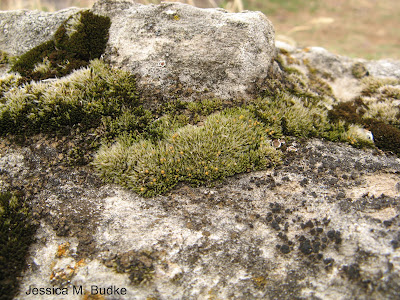Introducing
Jaffueliobryum wrightii! Finally I finished up my moss identifications from my field trip to Missouri and Kansas back in March. This is why I don't do much collecting. My collections tend to sit around for quite a while before identifying them makes it to the top of my list of things to do. And unless I have time for identifying them the mosses are best left growing in the wild.

So Jaffueliobryum wrightii is in the moss family Grimmiaceae. A telling feature is that the leaves have long, white awns at the tips. Thus, I jumped directly to the Grimmiaceae for my identifying. The genus Jaffueliobryum is usually found on calcareous rocks. This population was growing on sandstone. It doesn't really have a common name, but the genus was named for Félix Jafuell, a clergyman who collected plants in South America. There are only 3 species in North America. One only in Mexico and the other two are widely distributed across the western United States. So once I identified it to
Jaffueliobryum there were only two species to choose from. The other species, Jaffueliobryum raui, has keeled leaves (the same idea as the keel on a boat, they look folded or have a ridge down the center), which can be easily seen after making a leaf cross-section. Since this sample did not have keeled leaves, it was Jaffueliobryum wrightii.
It was a really fun plant to identify and I'm glad I got the chance to spend some time with it under the microscope. Now off to
the herbarium this sample goes.



















